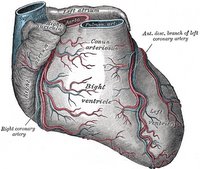The future of pharmacologic stress testing: selective A2A adenosine receptor agonist regadenoson (Lexiscan)?
 Adenosine and dipyridamole, the currently available vasodilators for myocardial perfusion imaging, produce hyperemic coronary flow by stimulating A(2A) adenosine receptors on arteriolar vascular smooth muscle cells. However, both vasodilators are nonselective activators of the adenosine receptors A(1), A(2B), and A(3), which contributes to common undesirable effects.
Adenosine and dipyridamole, the currently available vasodilators for myocardial perfusion imaging, produce hyperemic coronary flow by stimulating A(2A) adenosine receptors on arteriolar vascular smooth muscle cells. However, both vasodilators are nonselective activators of the adenosine receptors A(1), A(2B), and A(3), which contributes to common undesirable effects.Regadenoson is a new highly selective, low-affinity A(2A) adenosine agonist that is a coronary vasodilator. It was approved by the United States Food and Drug Administration on April 10, 2008 and it will be marketed under the tradename Lexiscan.

Regadenoson is an adenosine derivative as you can guess from its chemical name: 2-{4-[(methylamino)carbonyl]- 1H-pyrazol-1-yl}adenosine.
It has a 2-3 minute biological half-life, as compared with adenosine's 30 second half life. Regadenoson stress protocols using a single bolus have been developed, obviating the need for an intravenous line.
The dose is 0.4 mg of regadenoson (5 mL) delivered by rapid intravenous injection, regardless of body weight, to simulate exercise in radionuclide myocardial perfusion imaging.

Regadenoson should not be given to patients with sinus node dysfunction, unless they have a functioning pacemaker, or second- to third-degree atrioventricular block.
Other warnings in the prescribing information include risk of fatal cardiac arrest, ventricular arrhythmias, myocardial infarction, hypotension, and bronchoconstriction and respiratory compromise in patients with chronic obstructive pulmonary disease or asthma.
References:
The future of pharmacologic stress: selective A2A adenosine receptor agonists. Cerqueira MD. Am J Cardiol. 2004 Jul 22;94(2A):33D-40D; discussion 40D-42D.
Regadenoson, from Wikipedia, the free encyclopedia.
FDA Okays Regadenoson (Lexiscan) as Pharmacologic Stress Agent. Todd Neale, Staff Writer, MedPage Today, April 11, 2008.
Image source: Regadenoson, Wikipedia, public domain.
Image source: Heart, Gray's Anatomy, 1918, public domain.
Image sources: MI, Wikipedia.